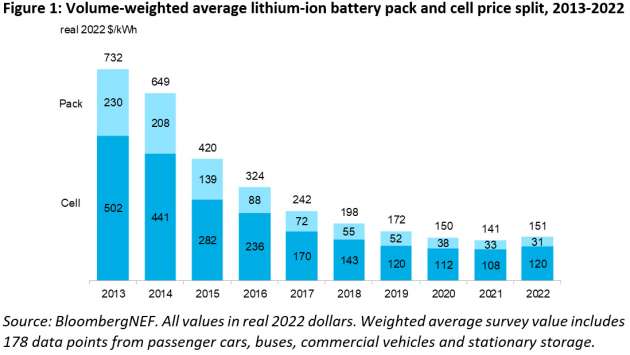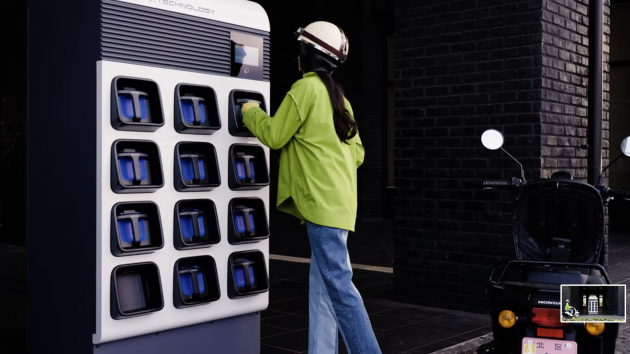
Lithium-ion battery pack prices have gone up for the first time since 2010 due to the rising cost of raw materials and battery components. This is according to a report by BloombergNEF (BNEF), which began tracking the battery market 12 years ago.
In 2022, the volume-weighted average prices for lithium-ion battery packs across all sectors have increased to USD151/kWh (RM665/kWh), representing a 7% rise from last year. The figure represents an average across multiple battery end-uses, including different types of electric vehicles, buses and stationary storage projects.
BNEF said the upward cost pressure on batteries outpaced the higher adoption of alternative and lower cost chemistries like lithium iron phosphate (LFP). It added that prices are expected to stay at similar levels in 2023, which would further defy historical trends.
From 2013 to 2021, the volume-weighted average prices for lithium-ion battery packs have decreased from USD732/kWh (RM3,226/kWh) to USD141/kWh (RM621/kWh), with 2022 marking the first time in more than a decade that an increase has occurred.

For EV battery packs in particular, prices were USD138/kWh (RM608/kWh) on a volume-weighted average basis this year. Meanwhile, at the cell level, average prices were at USD115/kWh (RM506/kWh), which indicates that cells account of 83% of the total pack price.
This was different compared to the previous three years when the cell-to-pack cost ratio typically hovered around a 70:30 split. One reason for this is changes to pack design, with manufacturers adopting new cell-to-pack approaches that help drive down costs.
On a regional basis, China saw the lowest battery pack prices at USD127/kWh (RM559/kWh), while packs made in the United States and Europe were 24% and 33% higher respectively. The report said the higher prices in those regions reflected the relative immaturity of those markets, the higher production costs, the diverse range of applications and battery imports. It also noted that low volume and bespoke order pushed prices up, especially in the higher end of the range.
While a 7% increase is noteworthy, BNEF said prices could have increased by much more in 2022 had it not been for the increased adoption of the low-cost LFP chemistry and continued reduction of the more expensive cobalt in nickel-base cathodes.

The numbers show LFP cells were 20% cheaper than lithium nickel manganese cobalt oxide (NMC) cells this year. Even so, LFP cell prices are influenced by lithium carbonate prices, and when viewed in isolation, LFP battery packs rose 27% in 2022 compared to 2021.
“Raw material and component price increases have been the biggest contributors to the higher cell prices observed in 2022. Amidst these price increases for battery metals, large battery manufacturers and automakers have turned to more aggressive strategies to hedge against volatility, including direct investments in mining and refining projects,” said Evelina Stoikou, an energy storage associate at BNEF.
For 2023, BNEF predicts average battery pack prices to remain elevated at USD152/kWh (RM669/kWh) despite prices for key battery materials like lithium, nickel and cobalt being moderated slightly in recent months.
With batteries making up a big chunk of an EV’s price, it’s not far-fetched to assume EV makers will hike the prices of their vehicles. This has already happened in the United States, with VinFast announcing in September that both the VF8 and VF9 will cost more due to rising material costs. The VF8 originally went for USD40,700 (RM179,243) but has been revised to USD42,200 (RM185,849).

It’s not all doom and gloom from here on, as BNEF predicts battery prices to start dropping again in 2024, when lithium prices are expected to ease as more extraction and refining capacity becomes available. Average pack prices are projected to fall below USD100/kWh (RM440/kWh) by 2026, which is two years later than previously expected.
This could be have negative consequences for automakers to produce and sell mass-market and affordable EVs in markets that do not offer subsidies or other forms of financial support to car buyers. Higher battery prices could also hurt the economics of energy storage projects.
“Despite a setback on price declines, battery demand is still reaching new records each year. Demand will reach 603 GWh in 2022, which is almost double that in 2021. Scaling up supply at that rate of growth is a real challenge for the industry, but investment in the sector is also rising rapidly and technology innovation is not slowing down,” commented Yayoi Sekine, head of energy storage at BNEF.
“Lithium prices remain high due to persistent supply chain constraints and the slow ramp up in new production capacity. Additional lithium supply could ease the pressure on prices in 2024, while geo-politics and trade tension remain the biggest uncertainties for other key battery metal prices in the short-term. Resolving these tensions could help calm prices in 2023 and beyond,” added Kwasi Ampofo, head of metals and mining at BloombergNEF.





More Stories
Purple Heart Car Donation Tax Deduction
Who Should Consider A Fat Tire Electric Bike?
G70 740i Test Drive Impressions Review (From a G12 M760 Owner)